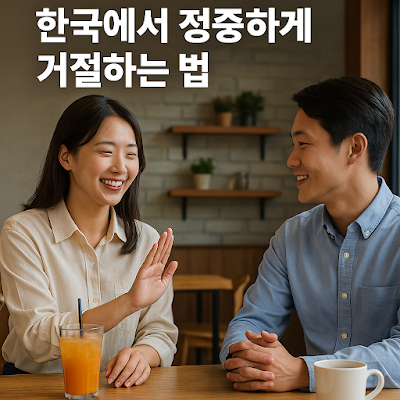Feel awkward turning down a drink, a dinner invite, or a request in Korea? You’re not alone—saying “no” directly can be tricky in a society that values harmony over confrontation.
This guide teaches you how to respectfully refuse in Korean settings without causing offense. From language tips to cultural cues, here’s how to navigate rejection with grace.
Why saying “no” is culturally sensitive in Korea
In Korean culture, direct refusals are often seen as confrontational or rude. People tend to avoid “straight no” responses in favor of softer expressions to maintain *nunchi*—the social awareness that underpins group harmony. Preserving relationships is often more important than stating your exact preference.
This leads to indirect phrases like “It might be difficult” (*조금 어려울 것 같아요*) or “Let me think about it” (*생각해볼게요*). These polite deflections allow both parties to save face without uncomfortable tension. Knowing when and how to use such phrases shows cultural fluency and respect.
Useful Korean phrases for polite refusals
Here are some go-to phrases to soften your “no”:
- “조금 어려울 것 같아요” – “It might be a little difficult” (common in declining invites)
- “이번에는 힘들 것 같아요” – “This time might be hard for me”
- “생각해볼게요” – “I’ll think about it” (often a polite no)
- “다음에 꼭 같이 해요” – “Let’s definitely do it next time” (shows goodwill)
- “죄송하지만...” – “I’m sorry, but…” (soft intro to refusal)
Non-verbal cues also help. Smiling gently, bowing slightly, or using a soft tone can convey sincerity even when declining.
When and how to say no without guilt
If you're offered alcohol and don’t drink, it's okay to say “술을 못 마셔요” (I can't drink alcohol), but always follow with a smile or compliment to ease tension. If you're refusing food, say it’s due to allergies or dietary preferences—Koreans usually respect personal health reasons.
In professional settings, refusals should be framed as scheduling issues or prioritization: “That might conflict with my current task.” Never be blunt or dismissive. Instead, express gratitude before refusal: “Thank you for thinking of me, but…” Small verbal cues make a big cultural difference.
Conclusion: Saying no with empathy is a sign of respect
Learning how to refuse in Korea isn't about being indirect—it’s about being empathetic and relationship-oriented. When done right, your “no” won’t close doors but open up respect. Mastering the art of polite refusal is a valuable tool in Korean social and professional life.
한국에서 술 권유나 식사 초대, 부탁을 거절할 때 괜히 어색하거나 미안한 기분 드셨나요? 한국은 조화를 중시하는 문화이기에, ‘아니요’라고 말하는 데도 기술이 필요합니다.
이 가이드는 한국 문화 속에서 예의 있게 거절하는 방법을 알려줍니다. 언어 표현부터 비언어적 제스처까지—거절도 배려로 이해되는 방식이 있습니다.
한국에서 직접적인 거절이 민감한 이유
한국 문화에서는 직설적인 거절이 무례하거나 대립적으로 여겨질 수 있습니다. 그래서 “아니요” 대신 완곡한 표현을 사용해 분위기를 부드럽게 하죠. 이는 *눈치*—즉, 사회적 분위기를 읽고 조화를 유지하는 능력—와 깊은 관련이 있습니다.
예를 들어, “조금 어려울 것 같아요” 또는 “생각해볼게요” 같은 말은 서로 체면을 지켜주는 완곡한 거절입니다. 이런 표현을 자연스럽게 쓰는 것은 문화적 배려이자 예의입니다.
예의 있는 거절을 위한 한국어 표현
다음은 부드럽게 거절할 때 쓸 수 있는 표현입니다:
- “조금 어려울 것 같아요” – (초대 거절에 자주 사용)
- “이번에는 힘들 것 같아요” – (부담 없이 상황 회피)
- “생각해볼게요” – (정중한 거절 표현)
- “다음에 꼭 같이 해요” – (다음 기회를 약속하며 긍정적으로 마무리)
- “죄송하지만...” – (정중한 거절 시작 표현)
거절할 때는 부드러운 미소, 살짝 고개를 숙이는 제스처, 조용한 어조 등 비언어적 요소도 매우 중요합니다.
죄책감 없이 거절하는 타이밍과 방법
술 권유를 받았는데 못 마신다면 “술을 못 마셔요”라고 말하면 됩니다. 다만, 미소나 감사 표현을 함께하면 분위기가 훨씬 부드러워집니다. 음식을 거절할 땐 알레르기나 식단 문제라고 설명하면 대부분 이해해줍니다.
업무 환경에서는 일정 충돌이나 우선순위를 이유로 설명하세요. 예: “지금 진행 중인 업무와 겹칠 수 있어요.” 이때도 감사 인사부터 시작하면 좋습니다. “말씀해주셔서 감사하지만…” 같은 표현이 큰 차이를 만듭니다.
결론: 배려 있는 거절은 존중의 표현입니다
한국에서의 거절은 무례함이 아닌, 관계 중심적인 예의입니다. 적절한 표현과 말투로 전달하면 오히려 더 큰 존중을 받게 되죠. 정중한 거절은 관계를 해치지 않고 오히려 신뢰를 쌓는 도구가 될 수 있습니다.
